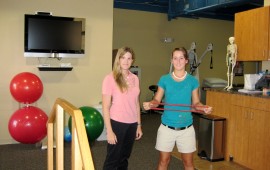National Physical Therapy Month
Author: Shannon Miller Lifestyle

When do you need Physical Therapy?
Many people start physical therapy because of an accident or trauma that makes certain movements difficult.
A physical therapist uses exercise, massage, and other techniques to help the person become more mobile in that area.
Your physical therapist can also:
- help reduce risk of injury
- improve balance and prevent falls
- help with diabetes
A physical therapist is much more than someone who helps move body parts. A trained and licensed physical therapist can test for, diagnose, and treat weaknesses and imbalances in the body. She may be able to see the root cause of the problem, where the person suffering may only find the symptom.
Injury happens in repetitive movement.
Golfers, tennis players, and baseball players know this all too well. Repetitive movement starts to add wear and tear to the joints and muscles involved. If one side uses more movement than the other, for instance, the body begins to lose musculoskeletal balance from one side to the other. The result could be injuries or falls.
In the case of Diabetes Type II, one of the roles of a physical therapist is to start a sedentary person on an aerobic routine with proper supervision. They can also help a diabetes patient develop muscle tissue, which in turn helps the body regulate blood sugar easier.
Stroke victims and brain injury patients are not always destined for a future of immobility.
Physical therapists know how to exercise the body and the brain, so that movement can become possible. Now, some stroke victims, with help of physical therapists, re-learn their muscle movements, and lead quite normal lives.
Balance problems can arise in anyone!
Balance problems lead to injuries and falls. They can become a problem for just about anyone. A physical therapist can work on a person’s stride in movement, as well as general balance and muscle toning exercises that balance the body. When the musculature and myofascial tissue is strengthened on both sides, balance problems and falling happen far less often.
Women, in fact, have difficulty as they age or as they become very active in sports, with joints and myofascial (connective) tissue. Because a woman’s body changes at puberty, pregnancy, and menopause, bones and structural tissue may not line up the way it did before.
The results of women’s body changes can be:
- joint pain
- back pain
- hip pain
- torn ligaments
- balance problems
